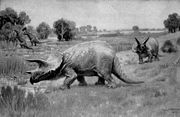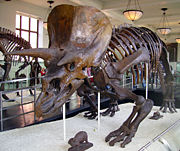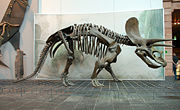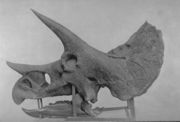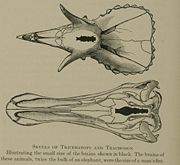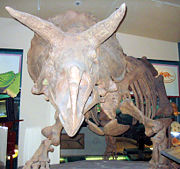Triceratops
2008/9 Schools Wikipedia Selection. Related subjects: Dinosaurs
| Triceratops Fossil range: Late Cretaceous |
||||||||||||||||||||
|---|---|---|---|---|---|---|---|---|---|---|---|---|---|---|---|---|---|---|---|---|
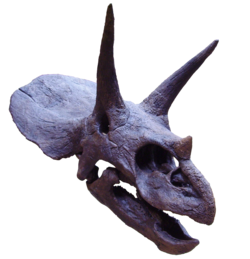 Triceratops skull, showing horns and frill, Oxford University Museum of Natural History.
|
||||||||||||||||||||
| Scientific classification | ||||||||||||||||||||
|
||||||||||||||||||||
| Species | ||||||||||||||||||||
|
||||||||||||||||||||
| Synonyms | ||||||||||||||||||||
|
Triceratops (pronounced /traɪˈsɛrətɒps/) is an extinct genus of herbivorous ceratopsid dinosaur that lived during the late Maastrichtian stage of the Late Cretaceous Period, around 68 to 65 million years ago (mya) in what is now North America. It was one of the last dinosaur genera to appear before the great Cretaceous–Tertiary extinction event. Bearing a large bony frill and three horns on its large four-legged body, and conjuring similarities with the modern rhinoceros, Triceratops is one of the most recognizable of all dinosaurs. The name Triceratops, which literally means "three-horned face", is derived from the Greek tri/τρι- meaning "three", ceras/κέρας meaning "horn", and -ops/ωψ meaning "face". Though it shared the landscape with and was preyed upon by the fearsome Tyrannosaurus, it is unclear whether the two battled the way they are commonly depicted in movies, children's dinosaur books and many cartoons.
Although no complete skeleton has been found, Triceratops is well-known from numerous partial specimens collected since the introduction of the genus in 1887. The function of their frills and three distinctive facial horns has long inspired debate. Although traditionally viewed as defensive weapons against predators, the latest theories claim that it is more probable that these features were used in courtship and dominance displays, much like the antlers and horns of modern reindeer, mountain goats, or rhinoceros beetles.
Triceratops is the best-known of the ceratopsids, though the genus's exact placement within the group has been a point of contention amongst paleontologists. Two species, T. horridus and T. prorsus, are considered valid, although many other species have been named.
Description
Individual Triceratops are estimated to have reached about 7.9 to 9.0 m (26.0–29.5 ft) in length, 2.9 to 3.0 m (9.5–9.8 ft) in height, and 6.1–12.0 tonnes (13,000-26,000 lb) in weight. The most distinctive feature is their large skull, among the largest of all land animals. It could grow to be over 2 m (7 ft) in length, and could reach almost a third of the length of the entire animal. It bore a single horn on the snout, above the nostrils, and a pair of horns approximately 1 m (3 ft) long, with one above each eye. To the rear of the skull was a relatively short, bony frill. Most other frilled dinosaurs had large fenestrae in their frills, while the frills of Triceratops were noticeably solid.
Triceratops species possessed a sturdy build, with strong limbs and short five-hoofed hands and four-hoofed feet. Although certainly quadrupedal, the posture of these dinosaurs has long been the subject of some debate. Originally, it was believed that the front legs of the animal had to be sprawling at angles from the thorax, in order to better bear the weight of the head. This stance can be seen in paintings by Charles Knight and Rudolph Zallinger. However, ichnological evidence in the form of trackways from horned dinosaurs, and recent reconstructions of skeletons (both physical and digital) seem to show that Triceratops maintained an upright stance during normal locomotion, with the elbows slightly bowed out, in an intermediate state between fully upright and fully sprawling (as in the modern rhinoceros). This conclusion does not preclude a sprawling gait for confrontations or feeding.
Classification
Triceratops is the best known genus of the Ceratopsidae, a family of large North American horned dinosaurs. The exact location of Triceratops among the ceratopsians has been debated over the years. Confusion stemmed mainly from the combination of short, solid frills (similar to that of Centrosaurinae), and the long brow horns (more akin to Ceratopsinae, also known as Chasmosaurinae). In the first overview of horned dinosaurs, R. S. Lull hypothesized two lineages, one of Monoclonius and Centrosaurus leading to Triceratops, the other with Ceratops and Torosaurus, making Triceratops a centrosaurine as the group is understood today. Later revisions supported this view, formally describing the first, short-frilled group as Centrosaurinae (including Triceratops), and the second, long-frilled group as Chasmosaurinae.
In 1949, C. M. Sternberg was the first to question this and favoured instead that Triceratops was more closely related to Arrhinoceratops and Chasmosaurus based on skull and horn features, making Triceratops a ceratopsine (chasmosaurine of his usage) genus. However, he was largely ignored with John Ostrom, and later David Norman, both placing Triceratops within Centrosaurinae.
Subsequent discoveries and analyses upheld Sternberg's view on the position of Triceratops, with Lehman defining both subfamilies in 1990 and diagnosing Triceratops as ceratopsine (chasmosaurine of his usage) on the basis of several morphological features. In fact, it fits well into the ceratopsine subfamily, apart from its one feature of a shortened frill. Further research by Peter Dodson, including a 1990 cladistic analysis and a 1993 study using RFTRA (resistant-fit theta-rho analysis), a morphometric technique which systematically measures similarities in skull shape, reinforces Triceratops' placement in the ceratopsine subfamily.
Use in phylogenetics
In phylogenetic taxonomy, the genus has been used as a reference point in the definition of Dinosauria; Dinosaurs have been designated as all descendants of the most recent common ancestor of Triceratops and Neornithes (i.e. modern birds). Furthermore, the bird-hipped dinosaurs, Ornithischia, have been designated as all dinosaurs with a more recent common ancestor to Triceratops than modern birds.
Origins
For many years the origins of Triceratops have been largely obscure. In 1922, the newly discovered Protoceratops was seen as its ancestor by Henry Fairfield Osborn, but many decades passed before additional findings came to light. However, recent years have been fruitful for the discovery of several dinosaurs related to ancestors of Triceratops. Zuniceratops, the earliest known ceratopsian with brow horns, was described in the late 1990s, and Yinlong, the first known Jurassic ceratopsian, in 2005.
These new finds have been vital in illustrating the origins of horned dinosaurs in general, suggesting an Asian origin in the Jurassic, and the appearance of truly horned ceratopsians by the beginning of the late Cretaceous in North America. As Triceratops is increasingly shown to be a member of the long-frilled Ceratopsinae subfamily, a likely ancestor may have resembled Chasmosaurus, which thrived some 5 million years earlier.
Discoveries and species
The first named specimen now attributed to Triceratops is a pair of brow horns attached to a skull roof, found near Denver, Colorado in the spring of 1887. This specimen was sent to Othniel Charles Marsh, who believed that the formation from which it came dated from the Pliocene, and that the bones belonged to a particularly large and unusual bison, which he named Bison alticornis. He realized that there were horned dinosaurs by the next year, which saw his publication of the genus Ceratops from fragmentary remains, but he still believed B. alticornis to be a Pliocene mammal. It took a third and much more complete skull to change his mind. The specimen, collected in 1888 by John Bell Hatcher from the Lance Formation of Wyoming, was initially described as another species of Ceratops. After reflection, however, Marsh changed his mind and gave it the generic name Triceratops, accepting his Bison alticornis as another species of Ceratops (it would later be added to Triceratops). The sturdy nature of the animal's skull has ensured that many examples have been preserved as fossils, allowing variations between species and individuals to be studied. Triceratops remains have subsequently been found in the American states of Montana and South Dakota (in addition to Colorado and Wyoming), and in the Canadian provinces of Saskatchewan and Alberta.
Number of species
Within the first decades after Triceratops was described, various skulls were collected, which varied to a lesser or greater degree from the original Triceratops, named T. horridus by Marsh (from the Latin horridus; "rough, rugose", suggesting the roughened texture of those bones belonging to the type specimen, later identified as an aged individual). This variation is unsurprising, given that Triceratops skulls are large three-dimensional objects, coming from individuals of different ages and both sexes, and which were subjected to different amounts and directions of pressure during fossilization. Discoverers would name these as separate species (listed below), and came up with several phylogenetic schemes for how they were related to each other.
In the first attempt to understand the many species, Lull found two groups, although he did not say how he distinguished them: one composed of T. horridus, T. prorsus, and T. brevicornus; the other of T. elatus and T. calicornis. Two species (T. serratus and T. flabellatus) stood apart from these groups. By 1933, and his revision of the landmark 1907 Hatcher-Marsh-Lull monograph of all known ceratopsians, he retained his two groups and two unaffiliated species, with a third lineage of T. obtusus and T. hatcheri that was characterized by a very small nasal horn. T. horridus-T. prorsus-T. brevicornus was now thought to be the most conservative lineage, with an increase in skull size and a decrease in nasal horn size, and T.-elatus-T. calicornis was defined by large brow horns and small nasal horn. C. M. Sternberg made one modification, adding T. eurycephalus and suggesting that it linked the second and third lineages closer together than they were to the T. horridus lineage. This pattern was followed until the major studies of the 1980s and 1990s.
With time, however, the idea that the differing skulls might be representative of individual variation within one (or two) species gained popularity. In 1986, Ostrom and Wellnhofer published a paper in which they proposed that there was only one species, Triceratops horridus. Part of their rationale was that generally there are only one or two species of any large animal in a region (modern examples being the elephant and the giraffe in modern Africa). To their findings, Lehman added the old Lull-Sternberg lineages combined with maturity and sexual dimorphism, suggesting that the T. horridus-T. prorsus-T. brevicornus lineage was composed of females, the T.calicornis-T.elatus lineage was made up of males, and the T. obtusus-T. hatcheri lineage was of pathologic old males. His reasoning was that males had taller, more erect horns and larger skulls, and females had smaller skulls with shorter, forward-facing horns.
These findings, however, were contested a few years later by Catherine Forster, who reanalysed Triceratops material more comprehensively and concluded that the remains fell into two species, T. horridus and T. prorsus, although the distinctive skull of T. (now tentatively Diceratus) hatcheri differed enough to warrant a separate genus. She found that T. horridus and several other species belonged together, and T. prorsus and T. brevicornus stood alone, and since there were many more specimens in the first group, she suggested that this meant the two groups were two species. It is still possible to interpret this reasoning as describing a single species with sexual dimorphism.
Valid species
- T. horridus (Marsh, 1889) (originally Ceratops) ( type species)
- T. prorsus (Marsh, 1890)
Doubtful species
The following species are considered nomina dubia ("dubious names"), and are based on remains that are too poor or incomplete to be distinguished from pre-existing Triceratops species.
- T. albertensis ( C. M. Sternberg, 1949)
- T. alticornis ( Marsh, 1887 (originally Bison))
- T. eurycephalus ( Schlaikjer, 1935)
- T. galeus (Marsh, 1889)
- T. ingens ( Lull, 1915)
- T. maximus ( Brown, 1933)
- T. sulcatus (Marsh, 1890)
Misassignments
- T. brevicornus (Hatcher, 1905) (=T. prorsus)
- T. calicornus (Marsh, 1898) (=T. horridus)
- T. elatus (Marsh, 1891) (=T. horridus)
- T. flabellatus (Marsh, 1889) (=T. horridus)
- T. hatcheri (Lull, 1907) (=Diceratus hatcheri)
- T. mortuarius ( Cope, 1874) (nomen dubium; originally Polyonax; =Polyonax mortuarius)
- T. obtusus (Marsh, 1898) (=T. horridus)
- T. serratus (Marsh, 1890) (=T. horridus)
- T. sylvestris (Cope, 1872) (nomen dubium; originally Agathaumas sylvestris)
Paleobiology
Although Triceratops are commonly portrayed as herding animals, there is currently no solid evidence that they lived in herds. Unlike other horned dinosaurs, some of which are known from sites preserving dozens or hundreds of individuals, all Triceratops finds known at present preserve only solitary individuals. However, these remains are very common; for example, Bruce Erickson, a paleontologist of the Science Museum of Minnesota, has reported having seen 200 specimens of T. prorsus in the Hell Creek Formation of Montana. Similarly, Barnum Brown claimed to have seen over 500 skulls in the field. Because Triceratops teeth, horn fragments, frill fragments, and other skull fragments are such abundant fossils in the Lancian faunal stage of the late Maastrichtian ( late Cretaceous, 68 to 65 mya) Period of western North America, it is regarded as among the dominant herbivores of the time, if not the most dominant herbivore. In 1986, Robert Bakker estimated it as making up 5/6ths of the large dinosaur fauna at the end of the Cretaceous. Unlike most animals, skull fossils are far more common than postcranial bones for Triceratops, suggesting that the skull had an unusually high preservation potential.
Triceratops was one of the last ceratopsian genera to appear before the Cretaceous-Tertiary extinction event. The related Diceratus and Torosaurus, and the more distantly related diminutive Leptoceratops, were also present, though their remains have been rarely encountered.
Dentition and diet
Triceratops were herbivorous, and because of their low head, their primary food was probably low growth, although they may have been able to knock down taller plants with their horns, beak, and bulk. The jaws were tipped with a deep, narrow beak, believed to have been better at grasping and plucking than biting.
Triceratops teeth were arranged in groups called batteries, of 36 to 40 tooth columns, in each side of each jaw with 3 to 5 stacked teeth per column, depending on the size of the animal. This gives a range of 432 to 800 teeth, of which only a fraction were in use at any given time (tooth replacement was continuous and occurred throughout the life of the animal). They functioned by shearing in a vertical to near-vertical orientation. The great size and numerous teeth of Triceratops suggests that they ate large volumes of fibrous plant material, with some suggesting palms and cycads, and others suggesting ferns, which then grew in prairies.
Functions of the horns and frill
There has been much speculation over the functions of Triceratops' head adornments. The two main theories have revolved around use in combat, or display in courtship, with the latter thought now to be the most likely primary function.
Early on, Lull postulated that the frills may have served as anchor points for the jaw muscles to aid chewing by allowing increased size and thus power for the muscles. This has been put forward by other authors over the years, but later studies do not find evidence of large muscle attachments on the frill bones.
Triceratops were long thought to have possibly used their horns and frills in combat with predators such as Tyrannosaurus, the idea being discussed first by C. H. Sternberg in 1917 and 70 years later by Robert Bakker. There is evidence that Tyrannosaurus did prey upon them, as a Triceratops pelvis has been found with tyrannosaur toothmarks and subsequent healing, indicating the wound was made while the animal was alive.
In 2005, a BBC documentary, The Truth About Killer Dinosaurs, tested how Triceratops might have defended themselves against large predators like Tyrannosaurus. To see if Triceratops could have charged other dinosaurs, as would a modern-day rhinoceros, an artificial Triceratops skull was made and propelled into simulated Tyrannosaurus skin at 24 km/h (15 mph). The brow horns penetrated the skin, but the blunt nose horn and the beak could not, and the front of the skull broke. The conclusion drawn was that it would have been impossible for Triceratops to have defended themselves in this way—instead they probably stood their ground when attacked by large predators, using their horns for goring if the predator came close enough.
In addition to combat with predators using horns, Triceratops are classically shown engaging each other in combat with horns locked. While studies show that such activity would be feasible, if unlike that of present-day horned animals, there is no evidence that they actually did so. Additionally, although pitting, holes, lesions, and other damage on Triceratops skulls (and the skulls of other ceratopsids) are often attributed to horn damage in combat, a recent study finds no evidence for horn thrust injuries causing these forms of damage (for example, there is no evidence of infection or healing). Instead, non-pathological bone resorption, or unknown bone diseases, are suggested as causes.
The large frill also may have helped to increase body area to regulate body temperature. A similar theory has been proposed regarding the plates of Stegosaurus, although this use alone would not account for the bizarre and extravagant variation seen in different members of the Ceratopsidae. This observation is highly suggestive of what is now believed to be the primary function, display.
The theory of their use in sexual display was first proposed by Davitashvili in 1961 and has gained increasing acceptance since. Evidence that visual display was important, either in courtship or in other social behaviour, can be seen in the fact that horned dinosaurs differ markedly in their adornments, making each species highly distinctive. Also, modern living creatures with such displays of horns and adornments use them in similar behaviour. A recent study of the smallest Triceratops skull, ascertained to be a juvenile, shows the frill and horns developed at a very early age, predating sexual development and thus probably important for visual communication and species recognition in general. The large eyes and shortened features, a hallmark of "cute" baby mammals, also suggest that the parent Triceratops may have cared for its young.

